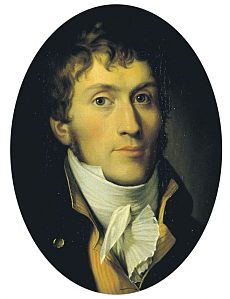Jørgen Jørgensen
| Jørgen Jørgensen | |
|---|---|

Jørgen Jørgensen by Eckersberg.
|
|
| Born |
29 March 1780 Copenhagen, Denmark |
| Died | 20 January 1841 (aged 60) Hobart, Van Diemen's Land |
| Nationality | Danish |
| Other names | the Dog-Days King |
| Occupation | Mariner |
| Known for |
Privateering, Exploring Tasmania |
Jørgen Jørgensen (name of birth: Jürgensen, and changed to Jorgenson from 1817) (29 March 1780 – 20 January 1841) was a Danish adventurer during the Age of Revolution. During the Action of 2 March 1808 his ship was captured by the British. In 1809 he sailed to Iceland, declared the country independent from Denmark and pronounced himself its ruler. He intended to found a new republic following the United States of America and France. He was also a prolific writer of letters, papers, pamphlets and newspaper articles covering a wide variety of subjects, and was an associate of the famous botanists Joseph Banks and William Jackson Hooker for a period. He left over hundred written autographs and drawings, most of them are collected in the British Library London. Marcus Clarke referred to Jørgensen as "a singularly accomplished fortune wooer—one of the most interesting human comets recorded in history".
Jørgensen was born as the second son of the royal watchmaker Jurgen Jurgensen. Two of his brothers have been watchmakers. The elder one was Urban Jurgensen, international reknownd. Jørgensen has been extraordinal strong and intelligent. At the age of 15 he finished successful school and headed for an apprentice to Captain Henry Marwood of the British collier Janeon. In 1799 he sailed to Cape Town and from there in 1800 to Port Jackson, the new British colony in Australia and to New Zealand. In 1801 he joined the crew of the Lady Nelson. As a member of that crew, Jørgensen was present at the establishment of the first settlements of Risdon Cove and Sullivans Cove in Van Diemen's Land, as Tasmania was then called. He has been called the founder of the city of Hobart Town, now Hobart, and is still a local hero.
...
Wikipedia
